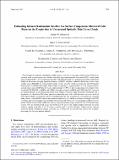Estimating Infrared Radiometric Satellite Sea Surface Temperature Retrieval Cold Biases in the Tropics due to Unscreened Optically Thin Cirrus Clouds
Author(s)
Marquis, Jared W.; Campbell, James R.; Cummings, James A.; Westphal, Douglas L.; Smith, Nathaniel J.; Zhang, Jianglong; Bogdanoff, Alec Setnor; ... Show more Show less
DownloadEstimating infrared radiometric.pdf (1.494Mb)
PUBLISHER_POLICY
Publisher Policy
Article is made available in accordance with the publisher's policy and may be subject to US copyright law. Please refer to the publisher's site for terms of use.
Terms of use
Metadata
Show full item recordAbstract
Passive longwave infrared radiometric satellite–based retrievals of sea surface temperature (SST) at instrument nadir are investigated for cold bias caused by unscreened optically thin cirrus (OTC) clouds [cloud optical depth (COD) ≤ 0.3]. Level 2 nonlinear SST (NLSST) retrievals over tropical oceans (30°S–30°N) from Moderate Resolution Imaging Spectroradiometer (MODIS) radiances collected aboard the NASA Aqua satellite (Aqua-MODIS) are collocated with cloud profiles from the Cloud–Aerosol Lidar with Orthogonal Polarization (CALIOP) instrument. OTC clouds are present in approximately 25% of tropical quality-assured (QA) Aqua-MODIS Level 2 data, representing over 99% of all contaminating cirrus found. Cold-biased NLSST (MODIS, AVHRR, and VIIRS) and triple-window (AVHRR and VIIRS only) SST retrievals are modeled based on operational algorithms using radiative transfer model simulations conducted with a hypothetical 1.5-km-thick OTC cloud placed incrementally from 10.0 to 18.0 km above mean sea level for cloud optical depths between 0.0 and 0.3. Corresponding cold bias estimates for each sensor are estimated using relative Aqua-MODIS cloud contamination frequencies as a function of cloud-top height and COD (assuming they are consistent across each platform) integrated within each corresponding modeled cold bias matrix. NLSST relative OTC cold biases, for any single observation, range from 0.33° to 0.55°C for the three sensors, with an absolute (bulk mean) bias between 0.09° and 0.14°C. Triple-window retrievals are more resilient, ranging from 0.08° to 0.14°C relative and from 0.02° to 0.04°C absolute. Cold biases are constant across the Pacific and Indian Oceans. Absolute bias is lower over the Atlantic but relative bias is higher, indicating that this issue persists globally.
Date issued
2017-09-05Department
Massachusetts Institute of Technology. Department of Earth, Atmospheric, and Planetary Sciences; Woods Hole Oceanographic InstitutionJournal
Journal of Atmospheric and Oceanic Technology
Publisher
American Meteorological Society
Citation
Marquis, Jared W. et al. “Estimating Infrared Radiometric Satellite Sea Surface Temperature Retrieval Cold Biases in the Tropics Due to Unscreened Optically Thin Cirrus Clouds.” Journal of Atmospheric and Oceanic Technology 34, 2 (February 2017): 355–373 © 2017 American Meteorological Society
Version: Final published version
ISSN
0739-0572
1520-0426